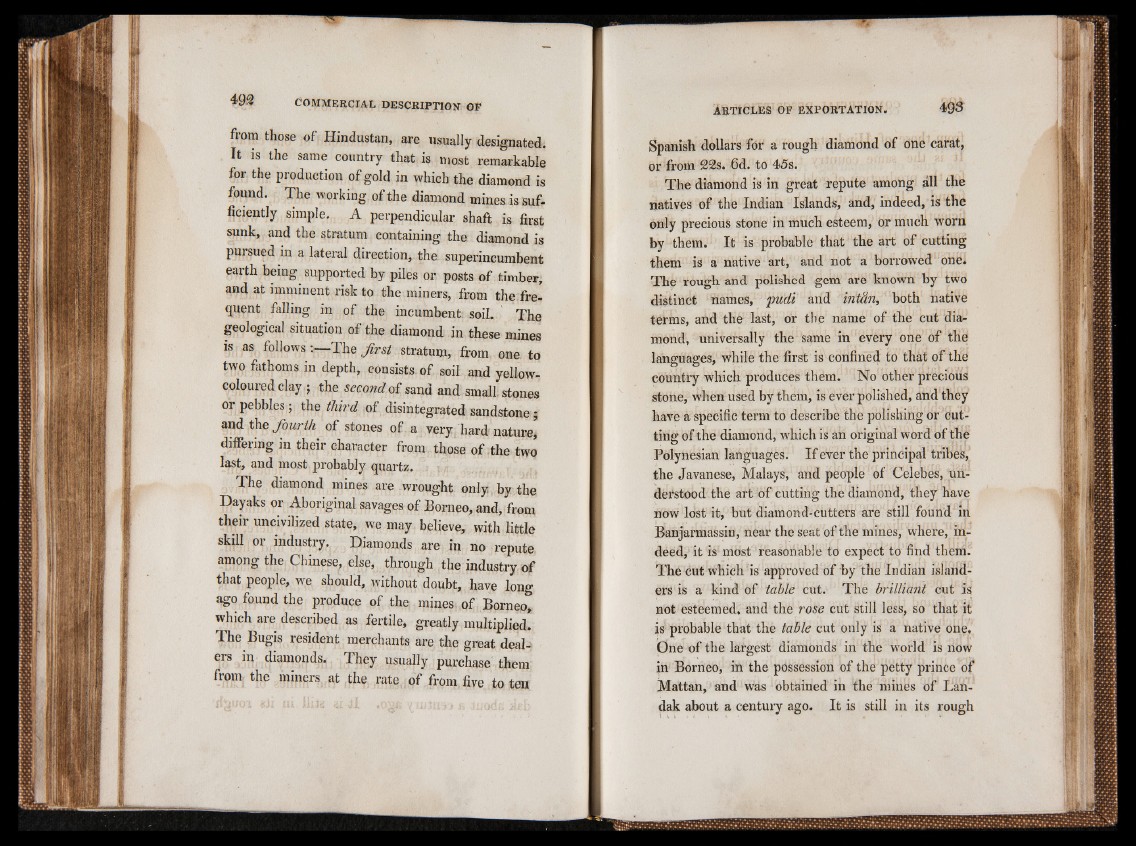
from those of Hindustan, are usually designated.
It is the same country that is most remarkable
for the production of gold in which the diamond is
found. The working of the diamond mines is sufficiently
simple. A perpendicular shaft is first
sunk, and the stratum containing the diamond is
pursued in a lateral direction, the superincumbent
earth being supported by piles or posts of timber,
and at imminent risk to the miners, from thefre-
quent falling in of the incumbent: soil. The
geological situation of the diamond in these mines
is as fol l owsThe ¿first stratum, from one to
two fathoms in depth, consists of soil and yellow-
coloured clay ; the second of sand and small, stones
or pebbles ; the third of disintegrated sandstone;
and the fourth of stones of a very hard nature,
differing in their character from those of the two
last, and most probably quartz.
The diamond mines are wrought only by the
Dayaks or Aboriginal savages of Borneo, and, from
their uncivilized state, we may believe, with little
skill or industry. Diamonds are in no repute
among the Chinese, else, through the industry of
that people, we should, without doubt, have long
ago found the produce of the mines of Borneo,
which are described as fertile, greatly multiplied.
The Bugis resident merchants are the great dealers
in diamonds. They usually purchase them
from the miners at the rate of from five to ten
Spanish dollars for a rough diamond of one carat,
or from 22s. 6d. to 45s.
The diamond is in great repute among all the
natives of the Indian Islands, and, indeed, is the
only precious stone in much esteem, or much worn
by them. It is probable that the art of cutting
them is a native art, and not a borrowed one.
The rough and polished gem are known by two
distinct names, pudi and intan, both native
terms, and the last, or the name of the cut diamond,
universally the same in every one of the
languages, while the first is confined to that of the
country which produces them. No other precious
stone, when used by them, is ever polished, and they
have a specific term to describe the polishing or cutting
of the diamond, which is an original word of the
Polynesian languages. If ever the principal tribes,
the Javanese, Malays, and people of Celebes, understood
the art of cutting the diamond, they have
nowr lost it, but diamond-cutters are still found in
Banjarmassin, near the seat of the mines, where, indeed,
it is most reasonable to expect to find them.
Thé cut which is approved of by the Indian islanders
is a kind of table cut. The brilliant cut is
not esteemed, and the rose cut still less, so that it
is probable that the table cut only is a native one,
One of the largest diamonds in the world is now
in Borneo, in the possession of the petty prince of
Mattan, and was obtained in the mines of Lan-
dak about a century ago. It is still in its rough